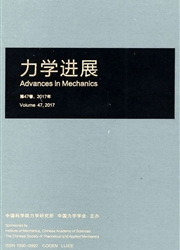

 中文摘要:
中文摘要:
首先综述了处理低速稀薄气体流动的一些方法:线化Boltzmann方程方法、Lattice Boltzmann方法(LBM)、加滑移边界的Navier-Stokes方程、以及DSMC方法,并讨论它们在模拟MEMS中过渡领域低速流动特别是内部流动所遇到的困难,其中表明了LBM现有方案不适合模拟过渡领域中的MEMS流动问题.信息保存(IP)法通过保存一个模拟分子所代表的大量分子的平均信息,克服了流速低使得信息噪声比小而引起统计模拟的困难.本文给出了方法的一些理论证文.MEMS中内部流动的特点,即流速低和大的长宽比的特点,引起椭圆性问题,即出入口边界条件相互影响需要协调的问题.通过对(长约几千微米的)微槽道流动应用IP方法的算例,演示了采用守恒形式的质量守恒方程和超松弛法可成功地解决这一问题.借助同样的方法,用IP方法求解了真实长度(1000μm)硬盘驱动器读写头在过渡领域的薄膜支撑问题,压力分布与具有严格气体动理论基础的概括化Reynolds方程完全相符,而在此之前,DSMC方法只对短的读写头(5μm)与Reynolds方程做了校验。作者建议将原来用于求解读写头润滑问题的Reynolds方程退化来求解过渡领域中的微槽道流动问题,从而提供了一个有严格气体动理论品性的检验方法来验证求解MEMS内部流动的各种方法。
 英文摘要:
英文摘要:
This paper reviews firstly method for treating low speed rarefied gas flows: the linearized Boltzmann equation method , the Latice Boltzmann method (LBM), the Navier-Stokes equation plus slip boundary conditions and the DSMC method, and discussed the difficulties in simulating low speed transitional MEMS flows, especially the internal flows. In particular, the present version of the LBM is shown unfeasible for simulation of MEMS flow in transitional regime. The information preservation (IP) method overcomes the difficulty of the statistical simulation caused by the small information to noise ratio for low speed flows by preserving the average information of the enormous number of molecules a simulated molecule represents. A kind of validation is given in this paper. The specificities of the internal flows in MEMS, i. e. the low speed and the large length to width ratio, result in the problem of elliptic nature of the necessity to regulate the inlet and the outlet boundary conditions that influence each other. Through the example of the IP calculation of the microchannel (thousands micrometers long) flow it is shown that the adoption of the conservative scheme of the mass conservation equation and the super relaxation method resolves this problem successfully. With employment of the same means the IP method solves the thin film air bearing problem in transitional regime for authentic hard disc write/read head length (L = 1000 micrometers) and provides pressure distribution in full agreement with the generalized Reynolds equation, while before this the DSMC check of the validity of the Reynolds equation was done only for short (L = 5 micrometers) drive head. The author suggests degenerate the Reynolds equation to solve the microchannel flow problem in transitional regime, thus provide a means with merit of strict kinetic theory for testing various methods intending to treat internal MEMS flows in transitional regime.
 同期刊论文项目
同期刊论文项目
 同项目期刊论文
同项目期刊论文
 期刊信息
期刊信息
